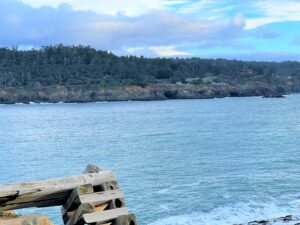There are tales, harrowing stories, which have been told and re-told for 167 years about the ship that was sucked into the blow hole in Mendocino Bay. Are they true?

The opening to the Mendocino Bay blow hole as seen from The Point on the Mendocino Headlands. (Photo by Carol Dominy)
Sidebar – we are not talking about the blow hole with a fence around it at The Point on the Mendocino Headlands. But, if you stand there, then turn eastward and look across the Bay at the rocky cliffs to the right of the highway bridge over Big River, you will see a large cavern.
While not visible from your present viewpoint, the cave has an opening to the sky. When the seas are running high and the wind is just right, sea water will shoot from the blow hole 150 feet into the air with a terrific roar, giving passing cars on the old highway route a saltwater bath.
The story begins on Wednesday, November 28, 1855, with three ships moored in the harbor at Mendocino Bay – a Chilean schooner called the La Paz, with a valuable cargo, and two American brigs, the North Bend and the Kingsbury. The day was bright, clear, and calm.
Suddenly, a heavy swell began rolling in from the southwest, breaking clear across the harbor from point to point. All three ships were torn from their mooring lines. The two brigs soon lay smashed to pieces upon the rocky shore, but the La Paz was propelled by the sea directly east across the bay to the dark mouth of the blow hole.
She hit the rocky entrance with tremendous force. The first impact took off her foremast and the rebounding current forced the ship backward out into the bay, where she was caught again and swept back into the hole. This time her main mast was snapped like a pipe-stem and the rigging carried away, and again she was washed out and caught in the surging waters. The third time she was dashed all the way in and nothing of her was ever seen again.
The 1855 Sonoma County Journal article describing the disaster also reported that the captain of the La Paz, Julio Chazelles, had drowned right there at Big River about three weeks before. Now his young wife and children, who were still on board the ill-fated ship at the time of her wreck, were all drowned in the cabin, as well as two of the crew. The mate and seventeen of her sailors were saved, as were the men on the other two ships.
The story was retold in the 1880 “History of Mendocino County,” and later in 1914 in Carpenter’s “History of Mendocino and Lake Counties,” who said the men were rescued by ropes in the hands of Charley Carlson and our very own William Kelley. Local history buff Bill Brazill says his grandmother told him that the struggling sailors were guided to land by bonfires on the beach lit by townspeople who had come to aid in the disaster.
Many accounts say that one of the survivors was a baby. After the ship had smashed into the blow hole and it seemed that all was lost, the young mother tied her tiny child into a chopping bowl and dropped it into the bay. The bowl and baby were washed near the shore and rescued. Mrs. Spencer Hills of Mendocino took the child and cared for it until the grandparents came from Chile about a year later and took it.
Over the years, curious people have ventured at low tide into the cave’s fifty- by forty-foot entrance. Among them was N. H. Falk who, with another man, rowed into the blow-hole for a distance of half a mile. The Beacon in 1917 described how “they found it quite spacious in places with a good depth of water and concluded that there was some outlet, probably on Big River. There is a place in the neighborhood of Van Loo’s gulch where old-timers say that a very distinct roaring can be heard, apparently from this cavern, when a heavy sea is running on the coast.”
According to late resident Florence Milliken Weber, the blow hole’s cave extends below ground for three miles, crossing under Big River and coming to the surface at Bishop’s pond near Big River. She said the sound of the underground river causes what used to be known as the “singing fishes” sound, another curious Mendocino phenomenon.
Divers on a 1966 underwater expedition found three separate caves inside. The one on the left extends about 150 feet back, coming to a dead end. The other two big caves split to the right going back about three hundred feet, which the divers estimated would take it under the Coast Highway, and then south for another four hundred feet. A big hollow room-like area with a huge domed ceiling is at the far end. “This probably traps the air and causes the interesting, rumbling sounds,” said diver Ed Braly.
Others believe those sounds come from the ghost of the ship’s wooden carcass, scraping against the walls of its rocky tomb.
If you have any information on Mendocino’s celebrated blow-hole or would like to add your images of it to our archives, drop us a line at curator@kelleyhousemuseum.org.
The Kelley House Museum and Research Office is located at 45007 Albion Street in Mendocino. Open Thursdays through Sundays, 11am to 3pm. 707-937-5791. Check out our website for the historic walking tour schedule and more information about the history of the Mendocino Coast.